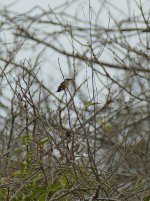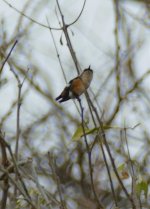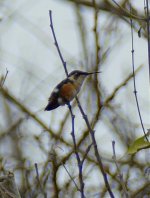Jens Thalund
Well-known member
On 7 May 2019 I was birding the dry shrub near Camarones, on the Caribbean coast in Northern Colombia, when I noticed a small hummingbird perched in the top of a bush some 25 meters away.
I quickly realised, that it was one of the Calliphlox Woodstars, in female/juvenile plumage, due to the rufous belly, white throat, long white eye-brow behind the eye, white puffs at the legs and small size.
No Calliphlox species should occur on the dry Caribbean coast, with the nearest being Santa Marta Woodstar in the Santa Marta mountains, but I am not familiar enough with this family, to rule out Amethyst or White-bellied Woodstar, both of which seem as unlikely to be found near Camarones, several hundred km from their nearest distribution.
I hope someone with more detailed knowledge will be able to comment on the bird, see attached photos.
Cheers
Jens
I quickly realised, that it was one of the Calliphlox Woodstars, in female/juvenile plumage, due to the rufous belly, white throat, long white eye-brow behind the eye, white puffs at the legs and small size.
No Calliphlox species should occur on the dry Caribbean coast, with the nearest being Santa Marta Woodstar in the Santa Marta mountains, but I am not familiar enough with this family, to rule out Amethyst or White-bellied Woodstar, both of which seem as unlikely to be found near Camarones, several hundred km from their nearest distribution.
I hope someone with more detailed knowledge will be able to comment on the bird, see attached photos.
Cheers
Jens







